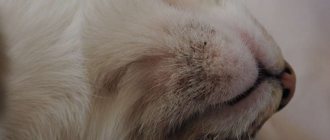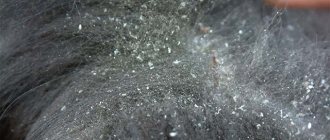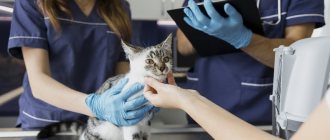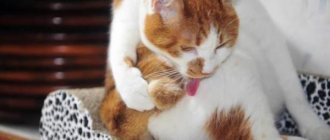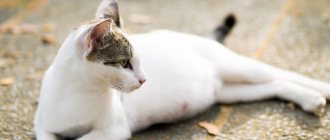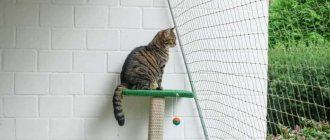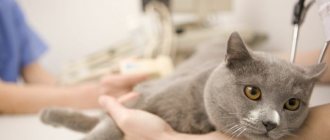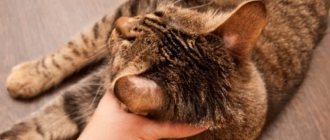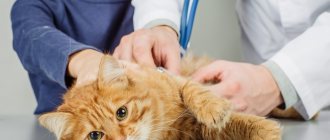Save the article:
Sometimes the owner, showing affection to his furry pet, notices that real dandruff has appeared in the cat’s fur. For many, this will be an unpleasant surprise, especially if the animal’s hygiene is observed according to all the rules. Dandruff in a cat looks the same as in humans - the top layer of skin gradually dies, and the scales flake off from the surface of the skin at a certain speed. Sometimes it happens that an excessive amount of dead cells is formed, then white skin particles appear on the fur, and the pet’s appearance becomes unkempt.
Can cats have dandruff?
Many people are surprised when they hear that cats have dandruff. But if we think based on physiology, then this is a completely common, although not frequent, phenomenon. The processes of skin renewal are constant, and old skin flakes need somewhere to go and they get stuck in the cat’s thick coat. The layer of particles on the wool can be dry or oily. The root cause of the sebaceous layer is often seborrhea.
global $ads_google; //data-ad-slot=”2475549904″ $ads_google = empty($ads_google) ? false : true; ?> if ($ads_google == false) {?>
$ads_google = true; ?> } ?>
If the dead horny layer looks like crumbled flour or even snow, then they talk about the dry variety, and with the oily type, the hairs at the base look stuck together and greasy. The type of disease depends on the individual characteristics of each pet’s body.
For some owners, this can be dangerous due to an allergy to cat dander, since a lot of cat saliva remains in the matted fur.
Causes of dandruff in cats
There are external and internal reasons for the appearance of particles of dead skin in an animal's fur, which explain why the skin looks untidy.
Internal reasons:
- fungal skin diseases inhibit healthy cells and contribute to their death and exfoliation;
- skin parasites such as fleas, ticks, lice eaters. With their vital activity, they cause itching in the cat and, as a result, scratching from the claws exfoliates skin particles even more;
- diseases associated with the gastrointestinal tract and others;
- diseases of the genitourinary system;
- disturbances at the hormonal level;
- disorders of the thyroid gland;
- diabetes;
- allergic reaction of cats to food or environmental factors;
- stress, fear, fears;
- reaction to certain medications. There are products that promote excessive dry skin. Shampoos that are not suitable for cats can have the same effect;
- dietary errors and lack of fatty acids in the diet;
- excess weight does not allow the pet to fully care for its fur coat in the back and tail area, so dandruff is often noticeable there.
External causes of dandruff include improper care of the pet: lovers of cat baths may one day be surprised to notice that “snow” is falling from the cat’s fur, or, on the contrary, sticky, unkempt fur has appeared behind the ears and on the back. If you are allergic to the shampoo, this will also be clear from the crumbling skin particles.
Dry air will affect the condition of the coat. If your home is excessively dry, this will soon affect your pet's skin. Sunburn will also make itself felt. No matter how old the animal is, dandruff can easily occur in both an old cat and a tiny kitten.
Diagnostics
Diagnosis of the causes of seborrhea begins with a general examination. The veterinarian asks about the pet’s diet and habits, its hygiene, and previous diseases. Blood and urine must be given for analysis, biochemistry, biopsy, and skin scraping. The presence of light yellow scales is caused by ultraviolet radiation, allergies, and disruption of internal organs.
Black dandruff appears due to infectious pathologies (fungi, parasites). An accumulation of scales near the tail occurs due to sunburn and obesity. If flakes are also found in the lumbar region, this may indicate dermatomycosis, helminthiases, and joint diseases.
Dandruff on a cat's back near the tail
Such a phenomenon as bran from dead skin on the body of a pet can appear near the tail. Sometimes the cat's heavy weight is cited as the reason - he is simply not able to clean the fur in this area. , tail dandruff only bothers the owner, but if the problem is not solved, then in addition to the unpleasant odor from the animal’s skin, hair loss in this area may begin.
Dandruff on a cat's back can be either dry or oily. The color of the scales does not depend on the color of the fur coat: the particles are gray, white and yellowish. If the color of the dead particles is black, this indicates parasites or fungal diseases in the cat. In any case, the first thing you should do is visit a veterinarian and get blood tests and cultures for the pathogen.
Primary or idiopathic dandruff
Idiopathic dandruff in cats is a genetic disease inherited in certain lines or families.
The cause is a pathology in the rate of renewal of epidermal cells. For cats, the norm is a cycle of 21 days, in this case it does not exceed 8 days. Although all felines are at risk, some breeds are predisposed to this type of seborrhea. These include Siberian, Persian, British. Most often, symptoms are visible already in the first months of a kitten’s life - the appearance of dead skin particles on the fur, alopecia (baldness), greasy-to-the-touch fur, and a specific bitter odor. Since the manifestations of primary seborrhea are similar to signs of metabolic disorders, the presence of parasites in a pet, or a reaction to stress, specialists are sought for help quite late (when the patient reaches the age of 12-14 months), when it becomes clear that other treatment methods are no longer suitable for the cat. fit.
Treating a cat for dandruff
To rid your pet of bran, you need to determine the reason that caused the increased exfoliation of dead skin particles. A small kitten can be very depressed by itching, so the investigation should not be delayed. You will probably have to deal with this for quite a long time: for example, if the cause is dry air in the apartment, then the problem requires a global solution.
Before going to a specialist with a question about how to treat dandruff in a cat , you can independently eliminate the cause of the phenomenon. Negative factors such as improper diet, inappropriate shampoo, and dry air can be easily corrected by owners without the intervention of a veterinarian, and additional drug treatment for back dandruff is not required.
It's worth asking yourself if your cat had something new in her diet after which dandruff was noticed. You can cure the attack by simply excluding the product from the menu.
global $ads_google; //data-ad-slot=”2475549904″ $ads_google = empty($ads_google) ? false : true; ?> if ($ads_google == false) {?>
$ads_google = true; ?> } ?>
If shortly before the “snowfall” the pet was given some kind of medicine from skin particles, this must be mentioned to the veterinarian during the examination. The doctor is even informed about procedures such as grooming performed in the salon and the latest treatment for parasites.
If it was not possible to eliminate the disease, then you should not try to become a veterinarian at home without special education: the doctor is much better able to detect a disorder in the cat’s body and prescribe appropriate effective treatment.
Anti-dandruff shampoo for cats
The first thing you should try after adjusting your diet is anti-dandruff shampoo. Such products function as antifungal, antibacterial and normalize the functioning of the sebaceous glands. The main active ingredients are zinc and salicylic acid. Thanks to their effect, the upper layer of skin is regenerated and wounds heal.
The most famous shampoo can be called a product called “Doctor” from TD Goodman. The advantages of the drug include the elimination of unpleasant odor, itching and allergic reactions. The shampoo is easy to foam and rinse off without leaving any residue, leaving the coat looking silky and shiny. If you want to get rid of skin flakes at once, then you should not hope for this - a noticeable effect is achieved in several applications over a long time.
Apply the shampoo to the coat and do not rinse off for 3-5 minutes. At this time, you should distract your pet and not let her try to lick the product.
It would be good if you consult a specialist before using the drug described above.
Professional-level shampoo from Anju Beauté is called super-cleansing. Its action is aimed at normalizing the functioning of the sebaceous glands, as a result the skin is degreased, the secretion of the sebaceous glands is reduced, and the coat itself is moisturized.
The composition contains nettle extract - the cat's coat will grow faster and look much neater and more beautiful.
The product is very economical - for washing it is used in a ratio of 1 to 5 with water.
Vitamins for cats against dandruff
In case of seborrheic revelry on the skin, a vitamin course will not be superfluous:
- Cat Felltop Gel with biotin and zinc is great for skin problems;
- Cat – Fell OK (Canina) – vitamin and mineral complex with an unlimited course of administration;
- Laveta Super for Cats (Beaphar) - thanks to vitamins B, E, biotin and taurine, the coat will become healthy and shiny.
- Derm Caps and Derm Liquid is an effective vitamin complex from German developers and is aimed at restoring the skin and improving the health of the coat;
Even the best vitamin complexes will not be able to help if the true cause of dandruff is not eliminated.
Anti-dandruff spray for cats
To treat dandruff in cats, you can use medicated sprays like Tropiclean Oxy-Med. This is a natural remedy with colloidal oatmeal, wheat germ proteins, vitamins B5 and E, and salicylic acid. All substances actively act on the affected area, healing both the skin and coat. Swelling is noticeably reduced and itching is eliminated, and the activity of the sebaceous glands is regulated.
Complications
Fatty particles of dead epithelium are noticeable in the highly shiny coat. And if you don’t look for the reason, the animal’s appearance will be neglected and unkempt. This disease signals problems in the body: leukemia virus, systemic lupus erythematosus, chronic liver disease, drug rash.
An untreated disease also leads to hair loss.
Seborrhea, as a cause of skin peeling, can easily be transmitted from one cat to another, which will also not make owners happy. Therefore, there is no place for thinking here - treat and treat again.
Black dandruff in cats
global $ads_google; //data-ad-slot=”2475549904″ $ads_google = empty($ads_google) ? false : true; ?> if ($ads_google == false) {?>
$ads_google = true; ?> } ?>
If the dandruff suddenly turns out to be black, and the color of the animal is also black, you should not calm down, this is not the norm. Particles of peeling skin can be light gray, cream, white, but if they are black, then there is a fungal disease or the presence of parasites in the body.
The cat has dandruff and hair loss
Yesterday my cat was diagnosed with dandruff, and today we noticed that she was shedding a lot of hair - yes, this happens. A cat with dandruff sheds much more, and can even get bald spots from actively trying to scratch its itchy skin.
The veterinarian will give a conclusion whether the cause is parasites, fungus or poor nutrition. In the first two cases, adequate medications will be prescribed, and nutrition will need to be adjusted at home. If the cat ate dry food, then you will have to choose a different type of food for it.
Stray dandruff in a cat
In addition to the usual dandruff, cats also have so-called wandering dandruff, which is caused by the Cheyletiella mite. The disease itself is called cheyletiellosis. The disease, unlike the word, is completely unsightly and extremely contagious for all pets with fur. The mite calmly moves in the keratin layer of the skin, so the dandruff itself, which covers the fur in a thick layer, also moves after the mite. Cheyletiellosis in cats is not difficult to identify: the tick itself can be seen with a good magnifying glass, and the fur looks like a battlefield: there are tracks on the skin everywhere along with a thick rash of skin scales.
Treatment of cheyletiellosis begins with cleaning with a vacuum cleaner, or better yet, with a steam generator, all the nooks and crannies of the home, with washing all bedding, rugs, and carriers. Then the cat begins to be bathed daily using sulfur-based preparations and even includes standard insecticides in the treatment.
Long-haired sufferers are recommended to have their hair cut for a speedy recovery.
Prevention of dandruff in cats
Although the phrase “it is easier to prevent a disease than to treat it” set everyone’s teeth on edge, it remained and will always remain the most faithful advice. The first thing you should do not only for your pet, but also for your own health is to think about the optimal level of air humidity in the apartment. Along with maintaining the humidity level, do not forget about the animal’s constant access to clean, fresh water.
To prevent the formation of creepy-looking, untidy tangles on the fur, clogged with particles of dead skin, the cat is washed with high-quality shampoo in warm, not hot water.
Of course, the presence of parasites in the cat’s life, both inside the body and on the fur, is unacceptable.
For those owners whose cats have access to walking, the advice will be relevant to avoid allowing your pet to stay in the sun for long periods of time.
It remains to add a recommendation for proper nutrition of the purr and the care of the owner, preventing possible stress.
How to prevent seborrhea
Try to help your pet get rid of the disease yourself using the following methods:
- carry out antiparasitic treatment at home;
- check the air humidity level, you may need a humidifier;
Bathing a cat to treat dandruff
- examine the animal’s fur for the presence of fleas and ticks, if necessary, use a special shampoo or spray to get rid of them;
- study the composition of your cat’s diet for foods that can cause allergies or digestive problems;
- evaluate the appearance of the animal, it may be obese, and it is necessary to adjust the diet and diet;
- do not wash your pet more than once every 2 months; when washing, use only shampoo intended for this purpose and not too hot water;
- check the composition of household chemicals used when cleaning the house; you may have to change the products to less allergenic ones.
Important! If after carrying out all the above measures the disease progresses, contact your veterinarian.
Prepare in advance the answers to the questions that the doctor will ask you at the appointment to make the correct diagnosis. List of sample questions:
- What is the cat’s diet (main products, diet, amount of food).
- Basic habits and behavioral characteristics of the pet (for example, does it like to lie in the sun, which can cause sunburn).
- How well are hygiene rules observed at home?
- What products and how often do you use when bathing your pet and cleaning the house?
- What vitamin supplements do you give?
- Where and in what conditions does the cat live?
- What was or is you sick with? What medications were used for treatment.
- How do you care for your fur?
After collecting anamnesis, the doctor will prescribe the following tests:
- general blood test and biochemistry;
- blood test for hormones;
- skin scraping;
- inoculation on a nutrient medium and identification of skin culture;
- skin biopsy.
